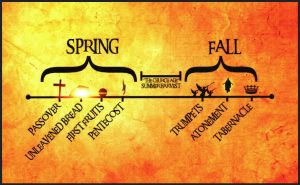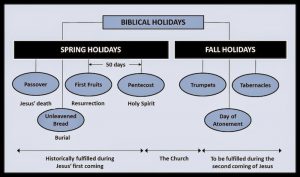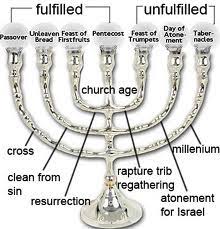The Seven Jewish Feasts and Their Relationship to Biblical Prophecy

I was born and raised a conservative Jew. In 1992, God saved me…praise Him! As a Christian-Jew, I am often asked a lot of questions about things of a Jewish (Old Testament) nature. You see, the Old Testament is old to me, the New Testament newer. Novel…huh? I am blessed to have this heritage, and also to be able to use this precious gift given to me by God to serve others in a teaching/preaching capacity in order to glorify Him. Related to this, last Spring I was very privileged to present a Passover Seder to a local churches youth group, drawing off of some of my own personal experiences celebrating this Jewish holiday as a boy. In addition, I was also very blessed to preach an Easter sermon at my local church, integrating Passover teachings into the Resurrection Sunday message.
I have a dear friend who for years has suggested I start a ministry due to this Messianic Jewish mix. The ministry name proposed: 1 (800) ASK-A-JEW. His idea is in order to allow others to ask me questions related to Judaism who are Christians. Periodically, I do get a call and the person on the other side of the phone says, “Is this 1 (800) ASK-A-JEW?” Guess who it is, or refers them to me? One day, Lord willing, I would love to formally do this. The problem right now with this is a lack of financial resources, and more importantly, no toll-free number in relation to “ASK-A-JEW” being currently available.Who knows, maybe one day this may become a reality, provided the Rapture does not occur before the opportunity arises (for more details on the upcoming Rapture, click on: The Rapture…It’s Clearly NOT a Matter of “IF” it Will Come, But Only a Matter of “WHEN!!!”).
As far as questions go, someone asked me recently about my biblical opinion in relationship to the seven Jewish feasts and how they may relate to biblical prophecy. This is not the first time I have been asked this question, nor do I have a feeling it will be the last. Hence this post. I am so thankful to the Lord for opportunities such as these. Suffice it to say, the biblical feasts and prophecy fit together…PERFECTLY! The information below which relates to this question is on the Waiting for Jesus website.
I hope the information I am posting blesses you as much as it blessed me. This insight about the Jewish feasts and their potential relationship to prophecy did not come overnight. This persuasion was brought to light during my personal studies, over many years, while being on my journey once I became a child of God.
(And please, this in no way has anything to do with date setting…so please do not misunderstand. It is more about the Jewish feasts painting an amazing picture of God’s prophetic redemption plan, ultimately through Yeshua Hamashiach (a.k.a. Jesus Christ)!
——————————————————————————————————
In Leviticus 23, I believe we can clearly see that the feasts of the Lord were appointed times, established as an annual foreshadowing, teaching both historically and prophetically the whole plan of God concerning the coming of the Messiah and the redemption of man; The first four feasts have been fulfilled and the Jewish community celebrates them historically. They are 1) Passover, 2) Unleavened Bread, 3) First Fruits and the 4) Feast of Weeks (a.k.a. Pentecost). These 4 Spring Feasts are considered to be an interrelated whole – and Pentecost was the completion of the seasons cycle.
*** Passover – pictures the death of Jesus Christ
*** Feast of Unleavened Bread – pictures the burial of Jesus Christ
*** Feast of First Fruits – pictures the resurrection of Christ
*** Pentecost – pictures the descent of the Holy Spirit & the birth of the Church

While the first four Festivals occur in close proximity, an entire season passes before the Fall Feasts begin. This long period can represent the dispensation of grace that we now live in (a.k.a. Church Age). The last three feasts (Trumpets, Atonement and Tabernacles) are celebrated in the Fall season and are yet to be fulfilled. Hence, they currently remain prophetic in nature.
*** Feast of the Trumpets – pictures the Rapture of the Church
*** Feast of Atonement – pictures the Second Coming of Jesus Christ
*** Feast of Tabernacles – pictures the Millennial Reign of Jesus Christ
The final three feasts are also known as Rosh HaShanah (Feast of the Trumpets), Yom Kippur (Feast of Atonement), and Sukkot (Feast of Tabernacles). The Feast of Trumpets will someday find its prophetic fulfillment (although no person knows the timing). Here are some reasons why the Rapture may occur during this Festival:
• All the Spring Feasts fulfilled prophecy of Christ’s first coming, and on exact days of a feast. All the Fall Feasts picture His Second Advent, and the Feast of Trumpets is the first of the Fall Feasts, picturing the Rapture extremely convincingly.
• The Feast of Trumpets is when the “last trump (shofar)” of the Rapture of 1st Corinthians 15 is blown.
• The Feast of Trumpets is known as the Wedding of the Messiah, and the Church is the Bride of Christ, and the Rapture is when the Church is caught up to heaven to be wed with Christ.
• The Feast of Trumpets happens on the “new moon,” which is 29.5 days after the last one, meaning it might occur on the 29th or 30th day – nobody knows for sure. “Of that day or hour no man knows” is an expression referring to this feast, and also the Rapture.
• We are told that the new moon and the Feasts of the Lord are a shadow of things to come in the New Testament, with the reality found in Christ (Col 2:16-17). The Feast of Trumpets is the only feast that falls on a new moon.
• “Of that day or hour no man knows, but my Father only” is an expression used by a groom when asked when his wedding will be. He says this because it is “his father” that will tell him when his preparations on the bridal chamber are completed and it is time. The Jewish wedding pictures the Rapture.
• In the wedding, the groom comes for his bride “like a thief in the night” – to take her away and into the bridal chamber for the bridal week at his father’s house. The Jewish wedding pictures end-times picture perfectly. (See Eschatology Understood Through a Jewish Lens – It’s Imperative! for more details on this.)
• Lastly, there are seven days between the Feast of Trumpets and the Day of Atonement. These possibly could picture the seven years of Tribulation. The Fall Feasts last for 10 days in total (called the Days of Awe) – 2 days for Trumpets, 7 days between these feasts, and 1 day for atonement.
God’s plan for humanity is clearly found in Leviticus 23 through the establishment of the Seven Feasts. The number seven throughout the Bible represents completeness. Just as seven days finish a weekly cycle, so could seven festival occasions complete the work of God on earth.
